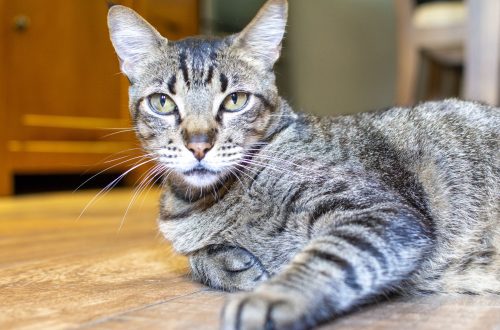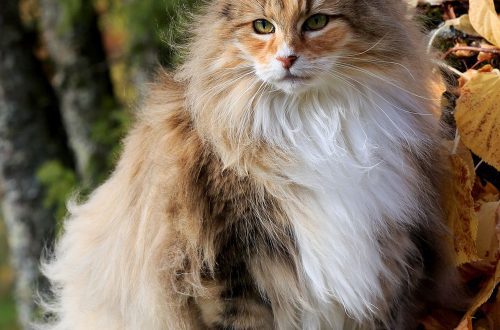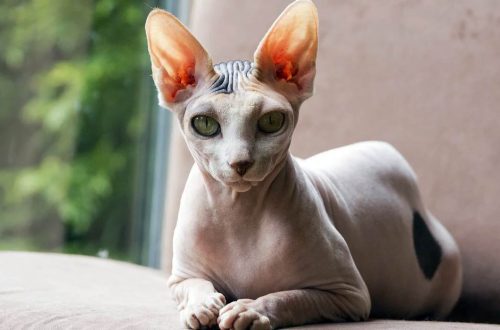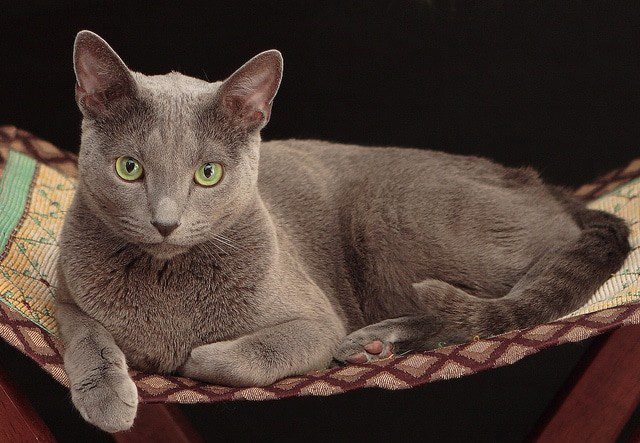
Russian Blue Cat
Other names: Arkhangelsk Blue , Maltese , Norwegian Blue , Spanish Blue , American Blue , Russian Shorthair
The Russian Blue cat is a green-eyed aristocrat who owes her popularity to her unique silver-blue coloration and innate sophistication. Curious intellectual and tireless hunter.
Contents
- Characteristics of Russian Blue Cat
- Basic moments
- History of the Russian Blue cat breed
- Video: Russian blue cat
- The appearance of the Russian blue cat
- Photo of Russian blue cat
- The nature of the Russian blue cat
- Training and education
- Care and maintenance
- Health and disease of the Russian blue cat
- How to choose a kitten
- Photo of Russian blue Kittens
- How much is a Russian blue cat
Characteristics of Russian Blue Cat
| Country of origin | Russia |
| Wool type | Shorthair |
| Height | up to 25 cm |
| Weight | 3–7 kg |
| Age | 16–20 years old |
Basic moments
- A distinctive feature of the breed is a reckless love for high jumps, so it is better not to keep vases and other fragile objects in the room where the animal lives.
- Russian blue cats are extremely clean, so an untimely or poorly washed tray is perceived as a personal insult.
- Adult animals are cautious and extremely shy. When a stranger appears in the house, they try to move away or hide.
- Cats are pretty independent. In the absence of proper attention from the owner, they are able to entertain themselves.
- Both kittens and adults love affection, but do not suffer from excessive obsession.
- Erudite, have a stable psyche, easily learn everything new.
- Due to the dense, thick coat, glycoproteins from the cat’s skin almost do not enter the environment, which makes the breed practically safe for allergy sufferers.
- Russian blue muroks have a very quiet voice, so they meow indistinctly.
- They are distinguished by good health. With proper care, they can live up to 20 years or more. There are cases in history when individual individuals managed to meet their own 25th anniversary.
- Animals do not tolerate intra-family conflicts. Frequent quarrels of households can turn the Russian blue cat into a nervous, intimidated and inadequate creature.
- From 2 to 4 kittens are born in one litter, therefore, in reputable catteries, offspring are distributed among potential buyers long before birth.
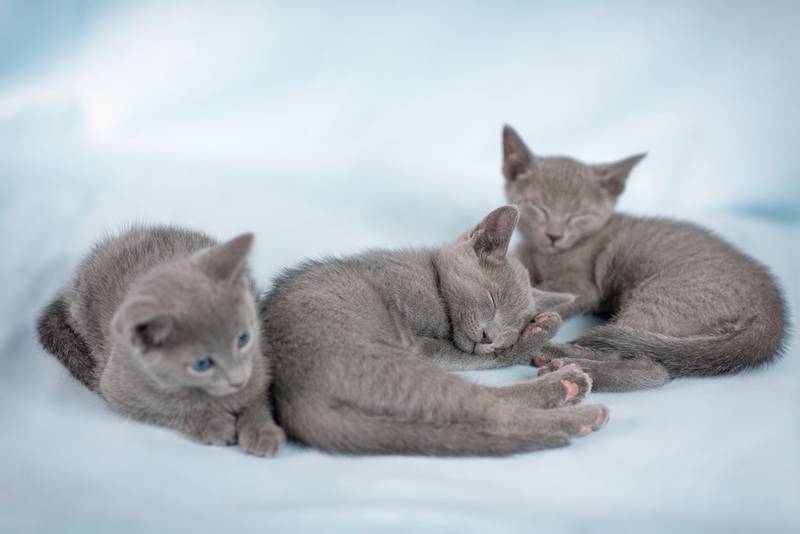
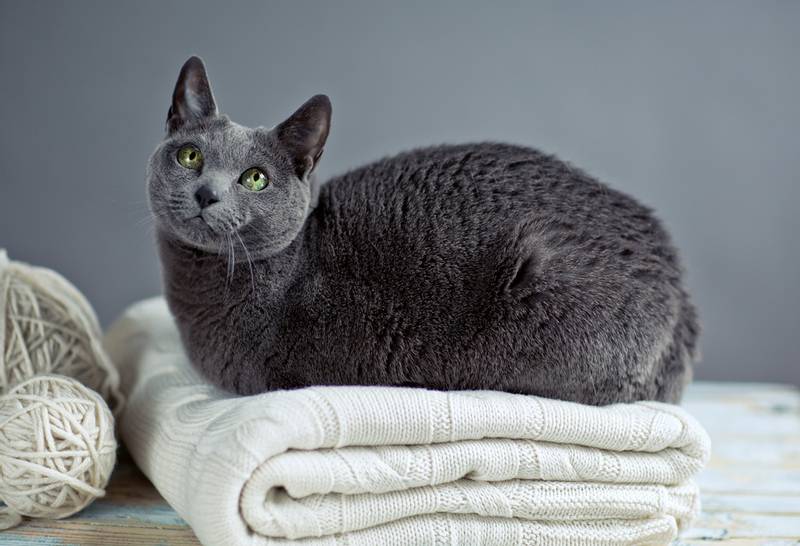
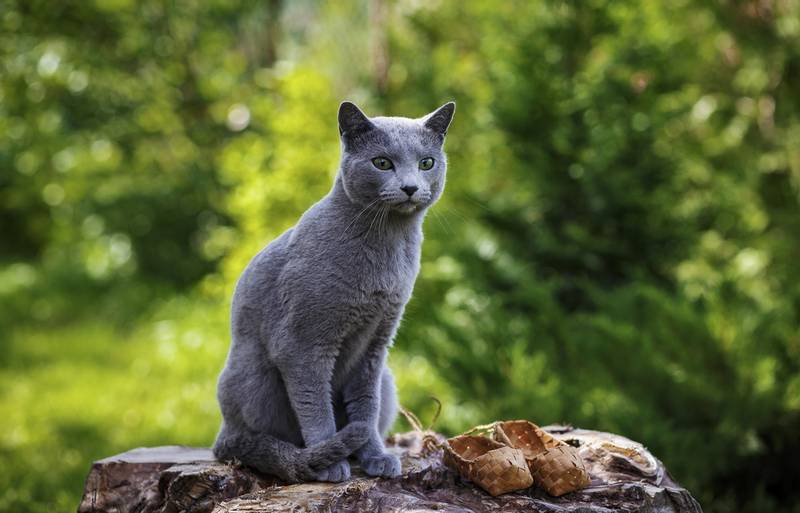
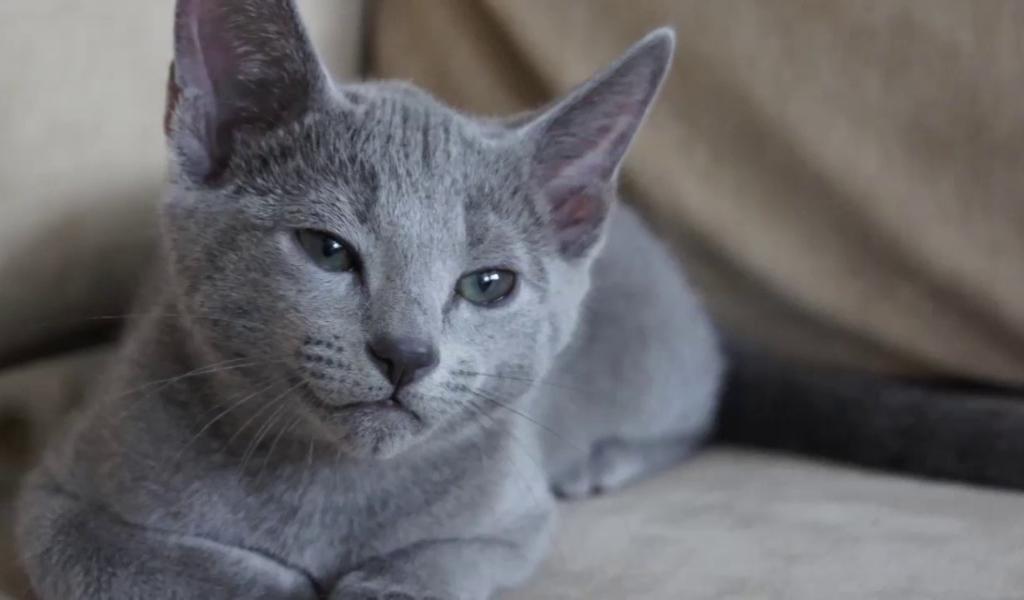
Russian blue cats are plush intellectuals, equally at ease in a modest city apartment and in royal chambers. In these graceful, majestic creatures, everything is perfect, from the ballet posture to the hypnotic, almost infernal look. Unobtrusive and delicate, they will not bother you with nightly “oratorios” and demands for every minute caresses. However, these fluffy nobles also do not intend to completely dissolve in the interests of the owner, because their purpose is to decorate, not brighten up life.
History of the Russian Blue cat breed
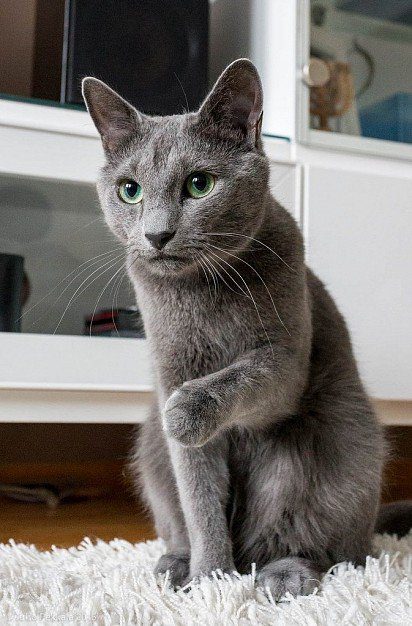
Plush murki began their triumphal march across countries and continents from Foggy Albion, where they earned the fame of unsurpassed rat-catchers. The “grandmother of all Europe”, Queen Victoria, was especially fond of blue-haired cats, at whose court many representatives of this wonderful family lived. History is silent about how cats got to Shakespeare’s homeland. The British breeders themselves are firmly convinced that their pets sailed to them from the Russian north, or rather, from the snowy Arkhangelsk. It was rumored that the first mustachioed “pomors” were presented to the British by Catherine II, who had a habit of presenting foreign ambassadors with all sorts of living curiosities. Apparently, since then, the breed has been assigned an alternative name – Archangel Blue (Arkhangelsk blue).
In 1893, the British breeder Karen Cox decided to “pump” the pedigree qualities of the Arkhangelsk cats a little and went to their supposed historical homeland – to Pomorye. There, the breeder managed to get hold of several kittens, which became the successors of the green-eyed “archangels” family. As for official recognition, it came to Russian blue cats only in 1912. 19 years after Mrs. Cox’s voyage, felinological associations finally approved a separate appearance standard for animals, thereby equalizing their rights with representatives of other cat breeds.
After the Second World War, the clan of Russian blue cats withered away and was on the verge of extinction, which greatly alarmed European breeders. Enthusiast breeders from Britain, Finland, Sweden and Denmark rushed to restore the number of “archangels”. And since it turned out to be an overwhelming task to find a sufficient number of purebred individuals for mating, the Russian Blue began to be crossed with representatives of other breeds that have a similar color. So the Arkhangelsk mousers became related first with the Siamese, and then with the British.
Knitting Russian cats with oriental individuals in England stopped pretty soon. The reason for the termination of the experiments was the inheritance of external defects and behavioral deviations by the offspring. The kittens’ character deteriorated, they became too nervous, meowed loudly, and when they grew up, they liked to mark corners. But the breeders from the USA were not embarrassed by such transformations and they continued their breeding research. As a result, the American branch of the Russian Blue breed was born, whose representatives had a pronounced oriental appearance, typical of the representatives of the Siamese group.
The Russian Blue cat breed came to Russia during perestroika times. Domestic breeders did not hesitate for a long time where to get purebred “material” for mating, and began to cross foreign individuals with native cats that have the same color and complexion. The experiment, oddly enough, turned out to be successful, and already in the early 90s, Russian catteries began to put up for sale the first Arkhangelsk blue kittens.
Video: Russian blue cat
The appearance of the Russian blue cat
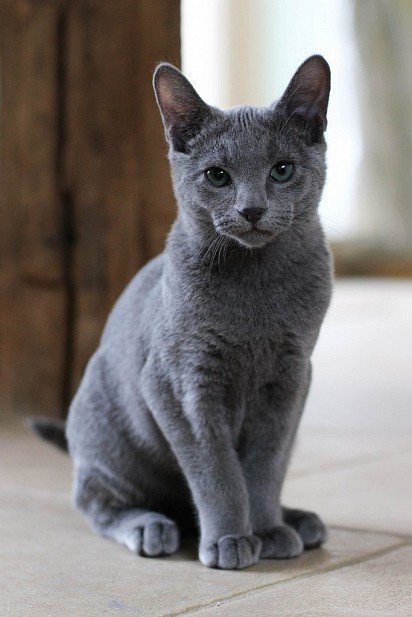
The Russian Blue cat is the epitome of grace and sophistication. Representatives of this clan are easily identified by their graceful posture and majestic “ballet” gait. The second identification sign of the breed is dense velvet coats of a bluish-ash color. It is thanks to the soft fur that is separated from the body that the silhouette of the animal acquires additional expressiveness and exquisite charm.
Depending on the place of breeding, three main types of appearance of the Arkhangelsk blue are distinguished:
- American (TICA standard) – oriental type, characterized by a wedge-shaped skull, large unfolded ears and a bright blue double coat;
- European (WCF standard) – with a flat skull and dense wool of a uniform blue tone with a silvery sheen;
- English (GCCF standard) – with a shortened wedge-shaped head and dense light blue fur, covered with a silvery “bloom” (silvering).
Head
According to the standard approved by the World Cat Federation (WCF), representatives of the Russian Blue breed should have a flat, moderately elongated skull and a straight nose, smoothly turning into the same even forehead and forming a slight bulge at the level of the eyebrows. The chin should be strong, rounded. Vibrissa pads are clear, moderately convex. The tone of the lobe is gray-blue.



Eyes
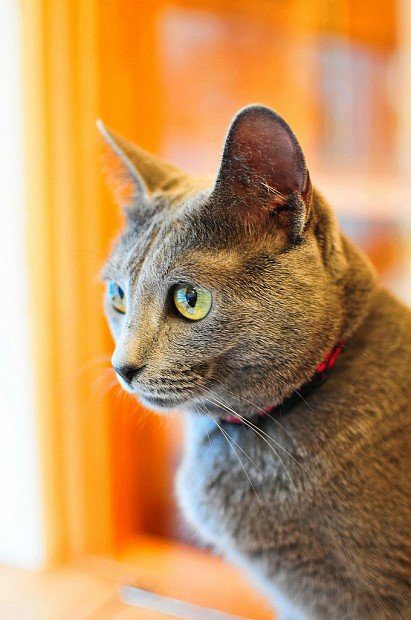
Large, oval, deep green. Set wide.
Ears
Large enough, leaning forward. The tip of the ear looks slightly pointed in “Americans” and more rounded in “Europeans”. The ear cloth is thin, elastic. The inner part of the ear funnel is slightly pubescent.
Neck
The neck of the Russian blue cat is long and graceful.
Frame
The cat’s body is muscular, slightly elongated, of medium size. For American cats, the light (oriental) physique is considered to be the reference.
limbs
Legs are long and straight. The paws of the Russian blue are oval, with soft elastic pads of a lilac-pink color. The “Americans” have pinkish-beige pads.

Tail
The tail of the cat is long, well pubescent, with a rounded tip.
Wool
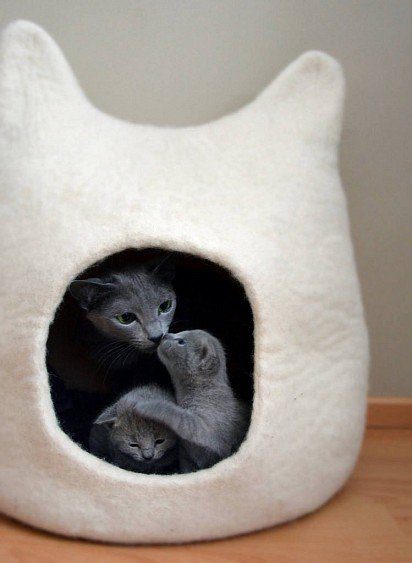
The coat of the “Europeans” is short, beaver-like and gives the impression of being very thick due to the equal length of the undercoat and outer coat. American fur coats have a plush structure.
Color
The ideal Russian Blue, from the point of view of the WCF commission, should have a uniform blue color of medium tone with a slight silvery tipping. The TICA standard prescribes for its pets a bright blue color type with a subtle silvery sheen.
Possible vices
One of the most common defects is the discrepancy between the coat color and the generally accepted standard. So, for example, even a purebred cat is able to bring offspring, among which a baby with a spotted coat can be found. The reason for such a marriage is a game of genes, so it is almost impossible to predict the likelihood of the birth of “wrong” kittens.
Serious shortcomings of the breed include a knotty tail with kinks, malocclusion, bulging or too deep-set eyes. The championship does not shine for individuals with a sagging spine, strabismus, and also hair that is tightly adjacent to the body. Polydactyl cats, cats that have undergone onychectomy (an operation to remove the claws), animals with color defects (spots on the coat with an area of more than 1 cm) and aggressive individuals are subject to unconditional disqualification.
Photo of Russian blue cat
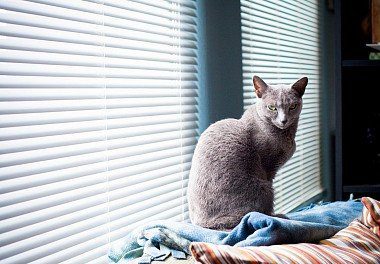

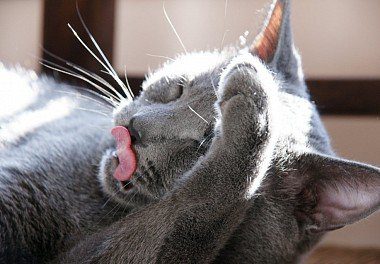
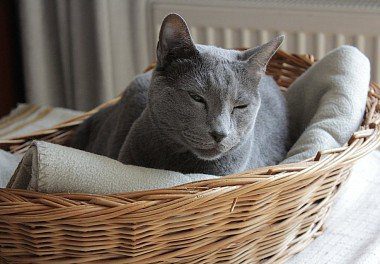

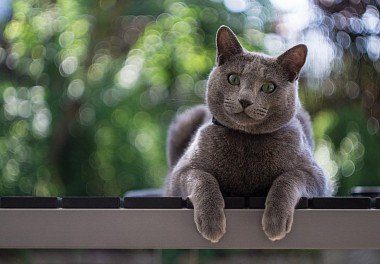
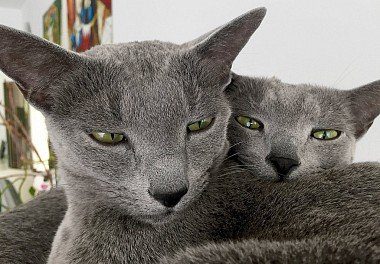
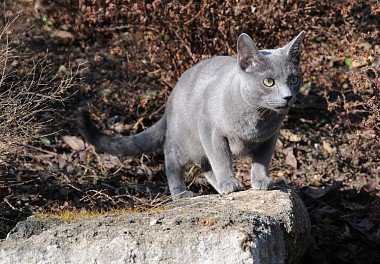
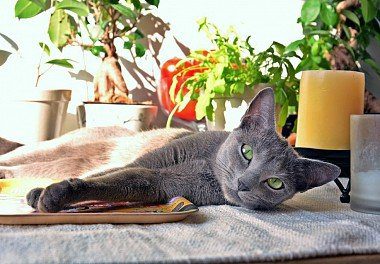
The nature of the Russian blue cat
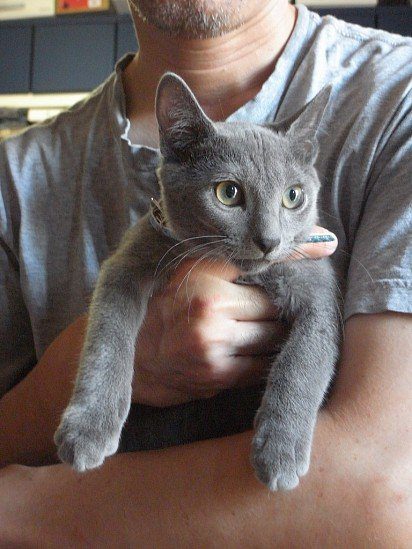
Russian blue-haired cats can be classified as trouble-free pets. Whims, self-will, deliberate sabotage – all this is beyond the understanding of plush aristocrats. Thanks to their innate intelligence and exceptional sensitivity, the Arkhangelsk cats give the impression of somewhat dependent persons, but you can’t blame them for being too soft-bodied. Russian blue cats are sweet and spontaneous only with their own households. This rule does not apply to strangers and unfamiliar people, so do not be surprised if, seeing guests on the doorstep, your pet immediately makes its feet.
It is believed that representatives of this breed are condescending to children’s pranks and do not lose their temper in situations in which any other cat would have long ago released its claws and issued a battle cry. However, leaving a small child and an animal alone is always an unjustified risk. In relation to other pets, the “archangels” are quite loyal. Moreover, cats are ready for a peaceful dialogue with any representative of the fauna, unless he attempts to provoke.
The favorite place of the Russian blue cat is not the owner’s knees or even a well-maintained house made of MDF, but any piece of furniture at least one and a half meters high, which, like Everest, is subject to immediate (and often multiple) conquest. As for affection, the mustachioed intellectuals accept it quite favorably, but they will not allow themselves to be squeezed to the point of fainting. In addition, in the soul of even the laziest Arkhangelsk cat-fee, a primitive hunter is sensitively dozing. This means that getting a mouse or other gaping rodent for a pet is a matter of honor.
In the absence of conditions for a full-fledged hunt (refers to individuals living in city apartments), Russian blue cats begin to make do with catching flies and other insects. For this reason, it is not recommended to leave animals in rooms with open windows and balconies. In pursuit of winged prey, pets lose their vigilance and often “fly out” of the apartment, injuring themselves.
Training and education
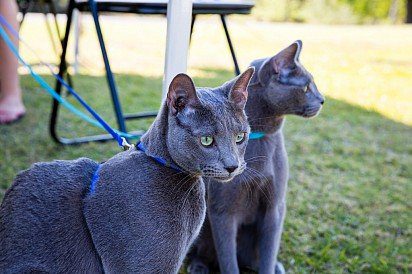
If you do not see a future circus show star in your pet, then the only thing you will have to work on with a Russian blue cat is the ability to properly use the tray. By the way, Arkhangelsk purrs learn this wisdom very quickly, an innate passion for cleanliness affects. The filler for the tray is better to use wood. If the animal was recently taken from the kennel, buy him the same kind of litter that the breeder used.
It is necessary to accustom a kitten to the toilet from the first days of being in a new home. The baby brought from the nursery is immediately seated in the tray and, stroking, is gently held in it for several minutes. In the first weeks, it is better to limit the pet’s habitat to one room (the kitchen is more suitable). So it will be easier for the kitten to get used to the new place, and the search for the toilet will not take much time.
If desired, the Russian Blue can be taught elementary commands (“Come to me!”, “Give me your paw!”). In this case, act as affectionately as possible, alternating short lessons with long rests and delicious rewards.
What not to do:
- tease the animal with finger movements and jokingly fight it with your hands. The Russian Blue sees this behavior as an impetus to action, and begins to practice hunting skills on your hands. For games, there are special items – “teasers”;
- swing at a pet caught at the “crime scene”, as well as spank it. You can express your dissatisfaction with a loud clap or a newspaper, as well as the command “Fu!”, Pronounced in a strict tone;
- punish the animal retroactively. Russian blue cats are able to draw the right conclusions only in a situation where they are scolded for mistakes made here and now.

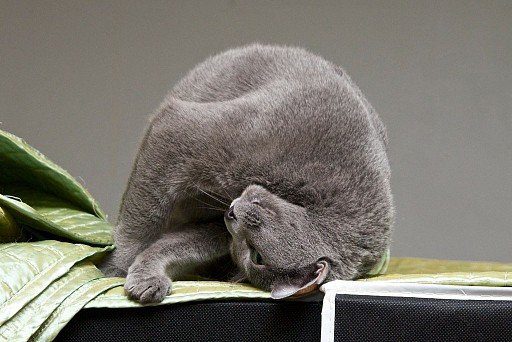
Care and maintenance
This is not to say that Russian blue cats require some kind of exceptional care. On the other hand, it is also impossible to ignore the pet at all, otherwise the animal will lose its external gloss, turning into an untidy, neglected creature.
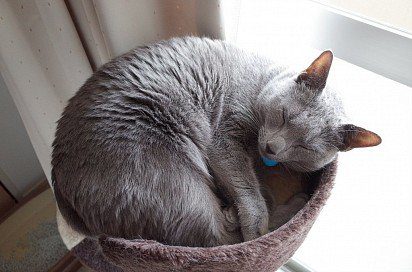
With the conditions of detention, everything is quite simple: plush cats easily take root both in penthouses and in small apartments. If your pet lives in a standard concrete “box”, make him happy with the purchase of a play complex. Having such “real estate” in their personal use, Russian blue cats encroach on the surface of furniture modules less often. In addition, it is not forbidden to walk the “archangels”: cats relatively easily get used to the harness and behave calmly during the walk.
Russian Blue babies are extremely curious and love to explore all the nooks and crannies of a new home. Accordingly, before turning on the washing machine, do not be too lazy to make sure that a fluffy explorer is not sitting in its drum. Wires, household chemicals and medicines pose a serious danger, so it is better to hide all these things from the kitten.
Hygiene
Russian blue cats have an inexplicable craving for water and can hypnotize the stream from the tap for hours, although frequent bathing is contraindicated for them. A full-fledged “wash” is arranged only for heavily soiled individuals, as well as individuals preparing for the exhibition. In all other cases, experts recommend using alternative washing using dry shampoo or bran. It is better not to use tinted detergents at all, since after them the cat risks losing its aristocratic silvering.
The eye examination of the animal is carried out daily. If contamination is found on the mucous membrane of the eyelid, they should be removed with a napkin or a clean handkerchief. Check your pet’s ears once a week. The oral cavity is examined at the same frequency and the condition of the teeth is assessed.
Cats have their nails trimmed once a month. It is necessary to cut off only the upper, sharp edge of the plate, without touching living tissues. If there are still injuries, treat the injured area with hydrogen peroxide. In cases where the pet is too resistant to the procedure, it can be stretched for several days.
Brush your Russian Blue once a week. At the end of the process, go over the pet’s fur with a suede napkin, which will give the “fur coat” a soft sheen. Despite the fact that Russian Blues do not shed too much, buying a furminator will not be superfluous. Choose models with short teeth that will help you effectively and painlessly remove dead hairs.
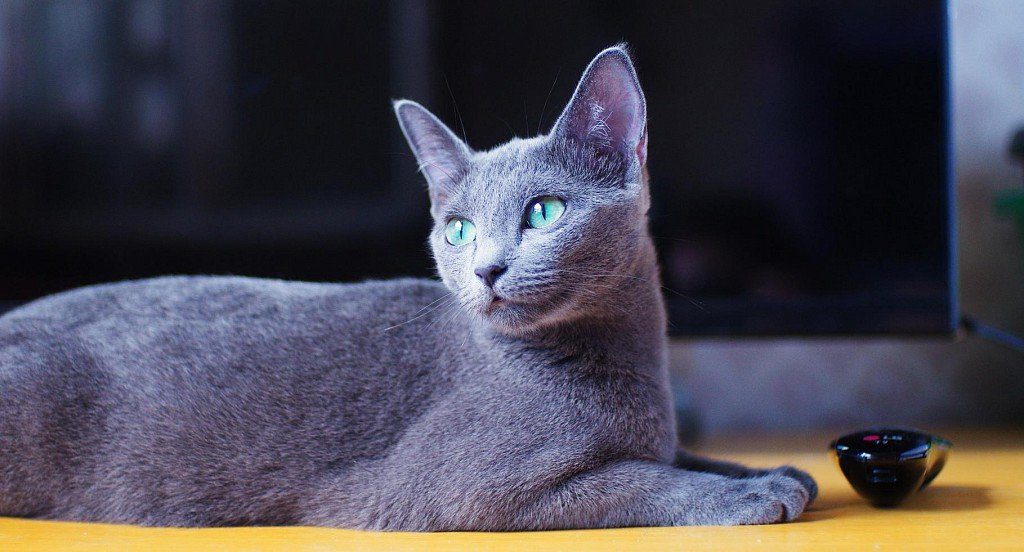
Food
The natural diet of the Russian blue cat is not much different from the menu of the same British. The main foods that plush murki can absorb without compromising their own digestion are poultry fillet, beef, vegetables and dairy products. Buckwheat, rice and oatmeal are also useful. It is better to completely exclude fish from the cat’s diet, but if you still decide to treat your pet to a forbidden delicacy, do this no more than twice a month.

- liver;
- onion and garlic;
- eggplant;
- bones;
- pork and any other fatty meat;
- spicy, spicy and smoked dishes;
- sweets;
- milk.
Of the industrial feeds, premium and super premium varieties such as Happy Cat, Royal Canin, Hills, Eukanuba and others will be the best options. Be sure to study the composition of the “drying”. The coat shade of Russian Blues is very capricious and can lose its exclusive silvery “pattern” if the feed contains processed sea mollusks and algae. And although such metamorphoses are a temporary phenomenon, it is not recommended to treat a cat with such “drying” before exhibition events. As for the transition from one type of dry food to another, it should be carried out smoothly, daily adding a small amount of a new product to the usual diet.
Important: experienced breeders advise alternating dry food with wet canned food in a 3:1 ratio. This approach to feeding will provide the animal’s body with a complex of essential vitamins and minerals and help save on the purchase of mineral supplements.
It is allowed to introduce dry food into the diet of kittens from the age of 2 months, but at first “drying” is offered to the pet in a soaked form. Complementary feeding with natural products can be started already at the end of the 1st month of life. As an additional source of protein, the baby is given grated cottage cheese, low-fat pasteurized milk, cheese and cereal cereals in milk.
During the “meal” of the pet, two bowls should stand in front of him: one with food, the second with water, and the latter should remain in the field of view of the animal around the clock. Even if your mustachioed gourmet prefers a natural diet, he still needs clean, cool water.
How to feed
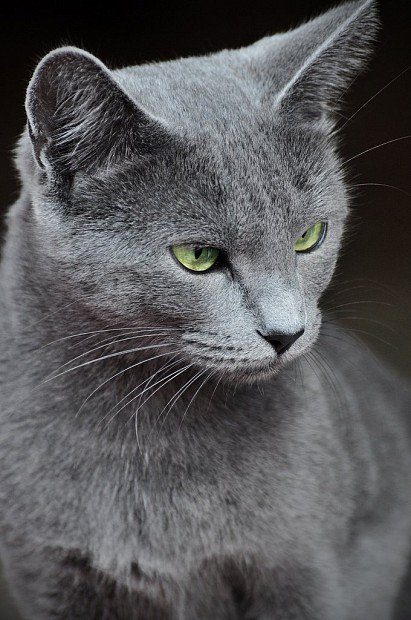
3-month-old babies are fed 5 times a day. For six-month-old individuals, the number of feedings is reduced to 4. At 9 months, a Russian Blue kitten is considered an adult, so it receives food twice a day.
Toilet
As true perfectionists, Russian blue cats are very sensitive to the cleanliness of their own tray. If the cat considers the toilet not “sterile” enough, blame yourself – the fluffy aristocrat will do his “business” in another, more decent, in his opinion, place. Sometimes defiant neglect of the tray can signal a pet’s readiness for marriage. Most often this is done by males. In exceptional cases, puddles on the floor are an expression of the hidden protest of the animal.
Why does the Russian blue cat change color?
The silver shade of the coat of the Russian blue cat is extremely unstable and dependent on external factors. Color changes can be provoked by direct sunlight, excess heat (if the cat sleeps on heaters), as well as malnutrition. If the pet’s diet is oversaturated with iron and copper, this will also not be slow to affect the color: the cat’s coat will darken sharply.
Health and disease of the Russian blue cat
The life expectancy of an average cat is 15-20 years. In general, representatives of this breed have good heredity and do not suffer from genetic ailments, however, they have a predisposition to diseases of the respiratory organs, as well as the digestive system. Most often, “archangels” suffer from gastritis and food allergies. In addition, with age, cats begin to accumulate excess fat, so it is very important not to overfeed the animal.
Timely vaccination will help prolong the life of your pet. In particular, Russian Blues should be vaccinated against calicivirus and herpesvirus infections, rhinotracheitis, chlamydia, rabies, panleukopenia and lichen.
Important: the sick animal must be immediately taken to the veterinary clinic. Do not try to treat the Russian Blue with pharmaceutical preparations on your own, as recommended on Internet forums. At best, such “therapy” will not give a result, at worst, it will aggravate the course of the disease.
How to choose a kitten
When choosing a kitten, focus on the conditions of his residence: the cleanliness of the cage and bedding, the presence of toys and water in the animal. You can make a discount on a light “cat” smell in the room. Eliminating the characteristic “ambre” in a place where several fertile males live is an almost impossible task.
- Take a close look at your kitten. The ideal Russian Blue baby should have green eyes. Do not buy yellow-eyed animals and do not believe the breeder’s oath that with age, the cat’s iris will change its shade to green.
- The coat of 3-month-old kittens should have traces of silvering, be sure to consider this fact when buying. Inclusions of white hairs and spots on the baby’s fur coat are a reason to doubt the honesty of the seller. But you should not be afraid of a slight “striping” (residual tabby). As the animal matures, this visual effect disappears.
- A healthy kitten should have clean ears and eyes. It is better not to consider individuals fleeing from you at full sail. This behavior indicates the instability of the animal’s psyche.
Serious establishments that value their own reputation start selling kittens from the age of 3 months. Breeders who offer too young specimens are simply saving on costs, as they do not want to feed an extra “mouth”. If you buy a kitten in another city or country, ask the owner if he can help you with the chipping procedure and issuing an exit certificate. Some catteries provide this support at a substantial discount as a reward for making a purchase.
By the way, about nurseries. Despite the popularity of the Russian Blue breed, there are not so many reliable places where you could buy a show or breed class animal in Russia. It is better and safer to buy a kitten from breeders who, in addition to mating and selling, are actively engaged in breeding activities. Another important point: the cattery must be registered in one of the felinological systems.
Photo of Russian blue Kittens
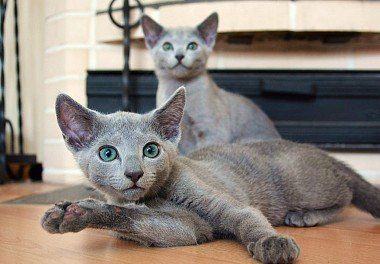
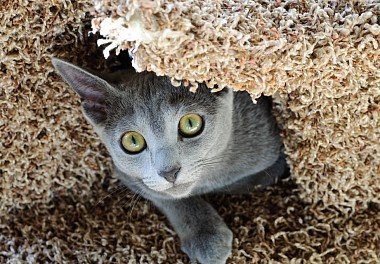
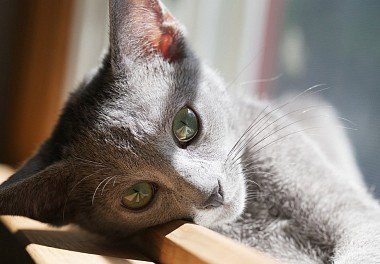
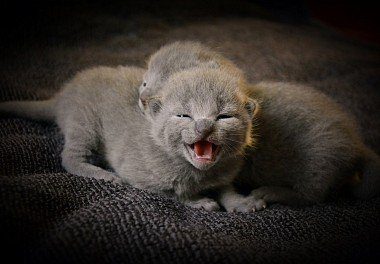
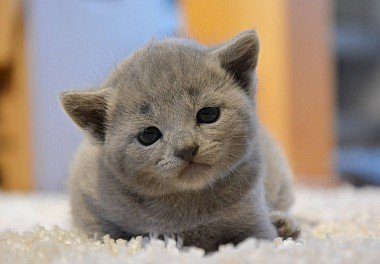
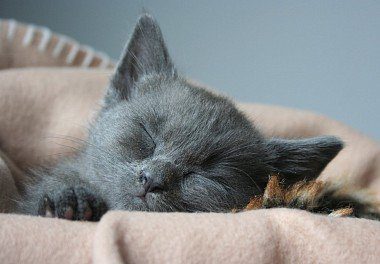
How much is a Russian blue cat
The Russian Blue is a fairly replicated breed, which could not but affect its price tag. In addition, it is necessary to take into account the costs of a nursery breeding blue-haired muroks. Participation in exhibitions, mandatory vaccinations, mating trips and participation in felinological seminars are not the cheapest pleasures, the cost of which the breeder is trying to “recapture” by selling kittens.
In most domestic catteries for a kitten of a Russian blue cat, they ask from 400 to 500$. A future champion with an impeccable pedigree will cost around 650$. Fans of risk and unhealthy savings can walk through virtual bulletin boards, where price tags for kittens are more pleasant: from 50-100$. For this amount, the buyer has the opportunity to purchase a mestizo, an animal without documents, or a baby born as a result of an unplanned mating.



